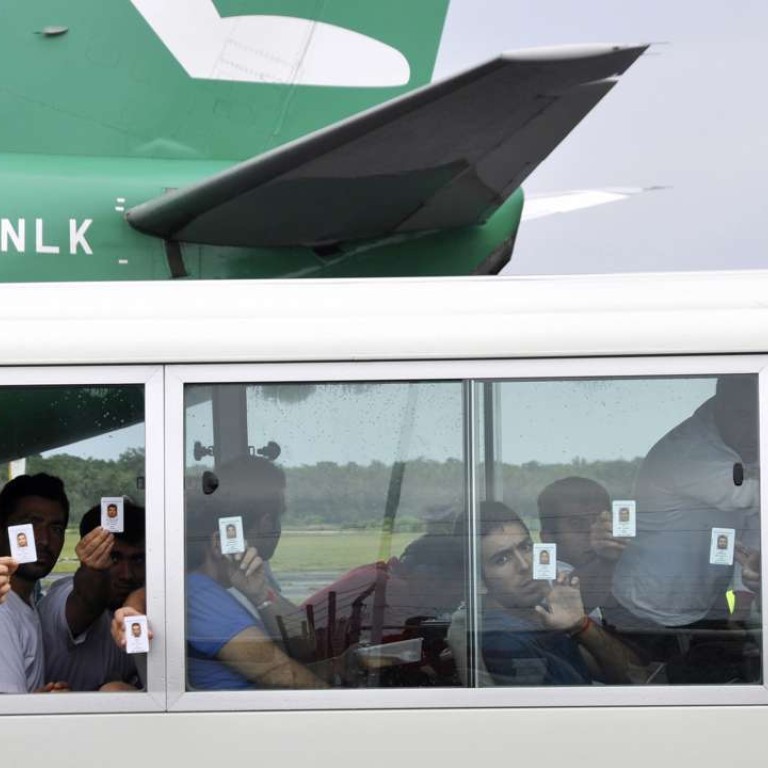
Who are the trapped refugees unwanted by Australia and Trump?
Of all the refugees in the world, these are among the most unfortunate — trapped for years in miserable island camps in the Pacific, unwanted by any nation.
Australia doesn’t want them. US President Donald Trump this week made it clear that a US agreement to accept 1,250 of them for resettlement was a “dumb deal” that he’d prefer to get out of.
“Do you believe it? The Obama Administration agreed to take thousands of illegal immigrants from Australia. Why?” he tweeted Wednesday.
The refugees are the collateral damage in Australia’s widely criticised “Stop the Boats” policy, the rule that asylum seekers who try to reach Australian shores by sea will never “make Australia home,” even if they are genuine refugees, are children or have skills.
“If you come to Australia illegally by boat, there is no way you will ever make Australia home,” an Australian army chief warned in a 2014 video aired online and on television in countries such as Iran, Afghanistan, Pakistan and Sri Lanka.
Watch: video warning refugees they would not make Australia home
The refugees at issue, mainly men, come from countries such as Iran, Afghanistan, Pakistan, Iraq and Somalia, including some of the seven majority-Muslim nations subject to Trump’s recent ban on refugees and others. But they also include some women and children.
Many risked their lives, travelling on decrepit boats to reach Christmas Island, an Australian territory near Indonesia. They were moved to detention camps on Manus Island in Papua New Guinea and Nauru, under Australia’s policy of processing asylum seekers offshore.
Some have now been trapped on the islands for years.
Cases of depression and self-harm are high, according to reports that have been leaked from the centres. Two people set themselves on fire last year, one of whom died. Australia was harshly criticised over a 26-hour delay in transferring the man, 23-year-old Iranian Omid Masoumali, to a hospital in Brisbane.
Many have reported that the biggest problem is the sense of paralysis at being trapped in limbo indefinitely, according to Tracey Donehue, a former teacher at one of the facilities. Some of her students had sewn their lips together, she said. One girl had swallowed bleach.
Amnesty International researcher Anna Neistat, who visited Nauru last year, said the apparent cruelty of their living conditions shocked her.

“Having worked in most of the world’s conflict zones over the last 15 years, I thought I had learned enough about suffering, injustice and despair. But what I saw and heard on Nauru will haunt me forever,” she wrote in a report on the camps.
In May, the UN High Commissioner for Refugees said that prolonged detention on the islands was “immensely harmful” and called for refugees and asylum seekers to be moved and treated humanely.
Last year, the refugees and asylum seekers were given permission to move out of the camps, but they are unable to leave the islands.
Australian political leaders have brushed off the criticisms, insisting that their policy saves lives by deterring people from trying to reach Australia in decrepit boats. They claim the policy is a success, because it did succeed in stopping the boats.

In 2014, Australia reached a deal with Cambodia to resettle the refugees there. But in October of that year, a number of Nauru asylum seekers sewed their lips shut to protest the plan. Just six refugees accepted the proposal and were flown to Cambodia in 2015 and 2016.
In November, shortly after Trump’s election, the Australian government announced it had reached a deal with the Obama administration to accept 1,250 of the refugees on Nauru and Manus Island. Priority was to be given to women and children, but few details were released.
Meanwhile, opinion polls last year appeared to show a shift in Australian public sentiment: In one survey, 64 per cent said they wanted the refugees on Manus Island and Nauru to be allowed into Australia.

Timeline of Trump-Turnbull spat
● Trump’s executive order on January 27 temporarily halting all refugee arrivals and stopping travellers from seven Muslim-majority countries - including Iran - sparked uncertainty in Australia, where questions were raised over whether the new administration would stick to the deal.
● Trump and Turnbull hold a pre-arranged phone call in which the refugee deal is discussed.
In a standard-looking readout of the call, Australia announces that Trump will honour the accord struck under his predecessor, with Turnbull declining to join international criticism of the travel ban and thanking Trump “for his commitment” to the deal.
● White House spokesman Sean Spicer confirms the deal will move forward, with the refugees to be the subject of “extreme vetting”.
Watch: Trump says not to worry about phone calls
● Turnbull tells reporters such conversations should be conducted “candidly, frankly, privately”. He added that the relationship with the United States was “very strong.”
● The US embassy in Canberra states that the refugee agreement has not changed and Spicer’s comments stand, according to Turnbull. The Australian leader added that this was confirmed to the US State Department by the White House and relayed to his government.
● Trump lashes out at the deal in a tweet that reads:
“Do you believe it? The Obama Administration agreed to take thousands of illegal immigrants from Australia. Why? I will study this dumb deal!”
● Turnbull denies Trump hung up on him and says he is disappointed details of the “very frank and forthright” exchange were leaked. However, he insists the US president agreed to honour the refugee deal.
Additional reporting by Agence France-Presse

